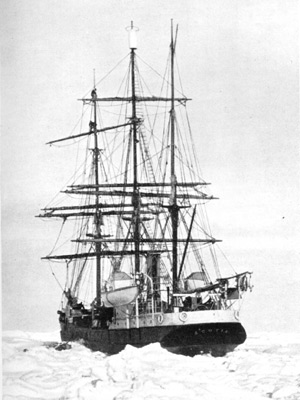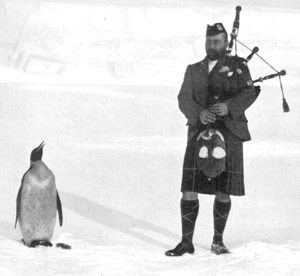
| Glasgow Digital Library | Voyage of the Scotia | BRUCE | PEOPLE | SHIP | ANTARCTIC | INDEX |
|---|

On 7 March 1904 Scotia was trapped between two streams of ice. Ice pushed up under the ship until the keel was over a metre above sea level.
After two days trapped in the ice, Scotia reached 74°01'S 22°00'W, 22km (14 miles) short of Weddell's furthest south. Three days later they thought they were trapped for the winter (not far from where Shackleton's Endurance was trapped). An inventory of stores was made. There was no relief ship and no wireless. They were on their own.
Research continued with soundings and traps through the ice. Emperor penguins wandered past the boat but showed no interest in Scotia - nor in the tunes played on the bagpipes by Kerr. Fifteen penguins were killed for food.
Bruce tried to raise the spirits of the crew by organising a football match. The weather turned very sunny and the temperature rose to -6°C (falling to -13°C at night). On 12 March the crew were resigned to another winter in the south. The Lucas sounding machine was loaded on to one of the sledges to take soundings in the vicinity of the ship. Suddenly cracks appeared in the ice and the sounding machine was brought back aboard.
Every effort was made to free the ship. Dynamite was used to blast holes in the ice and a cable was fixed in the ice attached to the ship's winch. This made no impact and the cable broke. Digging, hauling, shoving, jumping, running, blasting - all to no avail. The crew ran from one side of the ship to the other (33 people equals two tons in weight).
'After having been heaved out of the water into a veritable dry dock for six days', the ship suddenly freed herself and slid from her icy cradle into the sea - afloat once more. Soon, however, the open lead of water closed again around Scotia.
On 13 March Captain Robertson once more thought Scotia was trapped for the winter but between 6pm and 9:30pm they managed to steam 6.5km (four miles). On 14 March Scotia was in open water after 12 hours of tricky ice navigation between ten-metre-thick floes, charging at a crack and pushing some floes out of the way. Two bottles of champagne were opened and cigars issued as Scotia steamed free of the pack. The new land they discovered in Antarctica was to be called Coats Land.
Bruce was in no rush to go north once out of the pack. These were unexplored seas so trawling, soundings and water sampling were the order of the day. 'Ignorant people tell you there is no life in the Antarctic,' wrote Bruce but every dredge brought up a huge number of different life forms.

| Glasgow Digital Library | Voyage of the Scotia | BRUCE | PEOPLE | SHIP | ANTARCTIC | INDEX |
|---|